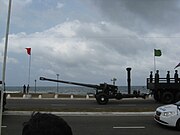Sri Lanka Army
| Sri Lanka Army | |
|---|---|
| ශ්රී ලංකා යුද්ධ හමුදාව(Sinhala) இலங்கை இராணுவம்(Tamil) | |
 Emblem of the Sri Lanka Army | |
| Founded | 1881 |
| Country | |
| Type | Army |
| Role | Land warfare |
| Size | 150,000 personnel[1] |
| Part of | Sri Lanka Armed Forces |
| Headquarters | Army Headquarters,Sri Jayawardenapura Kotte |
| Motto(s) | Latin:Pro Patria "For the Fatherland" |
| Colours | Gold, blue and orange |
| Anniversaries | Army Day:10 October[2] |
| Engagements | 1971 JVP Insurrection 1987–89 JVP Insurrection Sri Lankan Civil War |
| Decorations | Military awards and decorations of Sri Lanka |
| Website | www |
| Commanders | |
| Commander-in-Chief | Anura Kumara Dissanayake(President of Sri Lanka) |
| Commander of the Army | Lieutenant GeneralVikum Liyanage |
| Chief of Staff of the Army | Major General Dinesh Nanayakkara |
| Deputy Chief of Staff of the Army | Major General G.R.R.P Jayawardena |
| Notable commanders | |
| Insignia | |
| Flag | 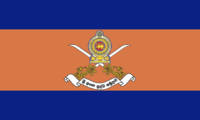 |
| Presidential Colour |  |
| Sri Lanka Army |
|---|
 |
| Components |
| History |
| Equipment |
| Leadership and ranks |
TheSri Lanka Army(Sinhala:ශ්රී ලංකා යුද්ධ හමුදාව,romanized:Śrī Laṃkā yuddha hamudāva;Tamil:இலங்கை இராணுவம்,romanized:Ilankai iraṇuvam) is the oldest and largest of theSri Lanka Armed Forces.The army was officially established as the Ceylon Army in 1949, though the army traces its roots back in 1881 whenCeylon Light Infantry Volunteerswas created; the army was renamed as the 'Sri Lanka Army' when Sri Lanka became arepublicin 1972. In 2024, the Army had approximately 150,000 personnel.[1][3]
TheArmy Headquartersis situated inSri Jayawardenepura Kotte;Commander of the Armyis the highest appointment in the army who commands the army and is assisted by theChief of Staff of the ArmyandDeputy Chief of Staff of the Army.[4][5]TheCommander-in-Chiefof theSri Lanka Armed Forcesis thePresident of Sri Lanka,who heads theNational Security Councilthrough theMinistry of Defence,which is charged with formulating, executing defence policy and procurements for the armed forces.[6]
Background
[edit]Pre Anuradhapura period to the Transitional period
[edit]Repeated incursions by South Indians, particularly theCholas,into Sri Lankan territory occurred throughout the next few centuries and led to the engagement of the rival forces in battle.[7]In one famous encounter, Sinhalese KingDutugamunu(161-37 BC) raised an army of eleven thousand in his battle against the Chola invaderElara,whom he eventually defeated. Dutugemunu's organisational skills, bravery and chivalry are famous and his battles have gone down in history as outstanding offensive operations.[8]
Other Sri Lankanmonarchswhose military achievements stand out includeGajabahu I(113-35), who sailed to India to bring back his captured soldiers, andDhatusena(455-73) who is credited with repulsing numerous Indian invasions and for organising a naval build-up to deter seaborne attacks. He also had the foresight to cover his defences withartillery.Vijayabahu I(1055–1110) was another warrior king who dislodged Indian invaders and united the country.Parakramabahu the Great(1153–86) was an outstanding monarch of thePolonnaruwa period,and his accomplishments as a military leader and a great administrator are noteworthy. His reign included a military expedition toBurmain retaliation for indignities inflicted on his envoys and Burmese interference in the elephant trade. This marked the first overseas expedition in Sri Lankan military history. It is also reported that Parakramabahu's fame was such that his assistance was sought by South Indian rulers who were involved in internecine struggles. Another strong ruler in theTransitional period of Sri LankawasParakramabahu VI,who defeated Indian invaders, united the island and ruled it from capitalKotte.[8]Although the knownepigraphicalrecords do not indicate that the Sri Lankan rulers had a full-timestanding armyat their disposal, there is evidence supported by legend, designation, name, place and tradition that prove there were 'stand-by'equestrian,elephant,andinfantrydivisions to ensure royal authority at all times.Militiaswere raised as the necessity arose, and the soldiers returned to their pursuits, mainly for farming, after their spell of military duty.[8]
Transitional period
[edit]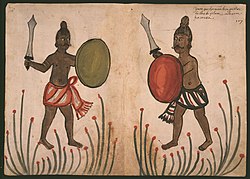
Parts ofSri Lankacame under the control of three colonial European powers, namely thePortuguesein the 16th century, theDutchin the 17th century and theBritishin the 18th century. Yet, until the entire island was ceded to the British in 1815, regional kingdoms maintained most of their independent defence forces and were able to successfully repulse repeated thrusts by the European armies. However the British, unlike their counterparts, were not primarily restricted to maritime power, and thus had the capability to bring the entire island under their control and to integrate locals into the British defence forces.[8]
At the beginning of the 16th century, modern Europe first came in contact with Sri Lanka. In 1505 aPortuguesefleet, while operating in the Indian seas against Arab traders, was blown off course and landed atGalle,on the southern coast of the island.[9]In 1517 the Portuguese re-appeared, and with the consent of the Sinhalese King established a trading post inColombo.Having initiated contact withSri Lankaas traders, the Portuguese soon made themselves political masters of the western seaboard. Numerous forts were soon established, and features ofEuropean civilisationwas introduced.[8]
The Portuguese are credited with the introduction of European-stylefortressesto Sri Lanka during this era. Although some locals already possessed military training and fighting experience, there is no evidence that the Portuguese employed local inhabitants into their own forces. Thus the Portuguese were forced to restrict their presence in the island due to their small numbers and their efforts were more focused toward projecting maritime power.[8]
In 1602Dutchexplorers first landed in Sri Lanka. By 1658 they had completely ousted the Portuguese from the coastal regions of the island. Much like thePortuguese,they did not employ locals in their military and preferred to live in isolation, pursuing their interests in trade and commerce. Like the Portuguese, they defended theirfortswith their own forces, but unlike the Portuguese, Dutch forces employedSwissandMalaymercenaries.The Dutch Forts inJaffna,Galle,Matara,BatticaloaandTrincomaleewere sturdily built and are considered a tribute to their military engineering skills. Also, like the Portuguese, the Dutch focussed on maritime power and although they had the capability to develop and use local forces, they chose to isolate themselves from the local population.[8]
Kandyan period
[edit]TheBritish Empirethen ousted theDutchfrom the coastal areas of the country, and sought to conquer the independentKandyan Kingdom.In the face of repeated British assaults, the Kandyans were forced into a degree ofguerilla warfareand fared well against their superior British adversaries.[8]
Initially the British stationed their forces, which included naval vessels, artillery troops and infantry, to defend the island nation from other foreign powers, using the natural harbor of Trincomalee as their headquarters in Sri Lanka. In 1796, the Swiss and Malay mercenaries who were previously in the service of the Dutch were transferred to theBritish East India Company.While the SwissRegiment de Meuronleft in 1806 and was eventually disbanded in Canada in 1822, the Malays, who initially formed aMalay Corps,were converted into the1st Ceylon Regimentin 1802 and placed under a British commanding officer. In the same year, the British became the first foreign power to raise aSinhaleseunit, which was named the2nd Ceylon Regiment,also known as theSepoy Corps.[8]
In 1803 the3rd Ceylon Regimentwas created withMoluccansand recruits fromPenang.All these regiments fought alongside British troops in theKandyan Warswhich began in 1803. Throughout the following years, moreSinhaleseand Malays were recruited to these regiments, and in 1814 the 4th Regiment was raised, which was composed entirely ofAfricantroops. It was later renamed as theCeylon Rifle Regiment.Eventually, theKandyan Kingdomwas ceded to the British in 1815, and with that they gained control over the whole island.Resistanceto British occupation cropped up almost instantly. During the first half-century of occupation, the British faced a number of uprisings, and were forced to maintain a sizable army in order to guarantee their control over the island. After theMatale Rebellionled byPuran Appuin 1848, in which a number of Sinhalese recruits defected to the side of the rebels, the recruitment of Sinhalese to the British forces was temporarily halted.[8]
History
[edit]Ceylon Volunteers
[edit]On 1 April 1881 by a proclamation issued by theGovernor of Ceylon,aVolunteer Forcewas raised in Ceylon. It was designated theCeylon Light Infantry Volunteers(CLIV) in an attempt to compensated for the disbandment of theCeylon Rifle Regimentin 1874. The Ceylon Light Infantry Volunteers was originally administered as a single regiment. However, over the years various sections of the volunteers grew large enough to become independent regiments. The different units that emerged from the Volunteer Force were the
- Cadet Battalion Ceylon Light Infantry
- Ceylon Artillery Volunteers
- Ceylon Engineers
- Ceylon Mounted Infantry(CMI)
- Ceylon Planters Rifle Corps(CPRC)[8]
- Ceylon Supply & Transport Corps
- Ceylon Volunteer Medical Corps
These volunteers saw active service when a contingent of the Ceylon Mounted Infantry (CMI) in 1900, and a contingent of the Ceylon Planters Rifle Corps (CPRC) in 1902, took part in theSecond Boer WarinSouth Africa.Their services were recognised by the presentation in 1902 of acolourto the CMI, and a presentation in 1904 of abannerto the CPRC.
Ceylon Defence Force Ordinance No. 8 of 1910
[edit]
In 1910, with the enactment of the Ceylon Defence Force Ordinance No. 8 of 1910, theCeylon Defence Force(CDF) was formed bring under it all volunteer units for administrative, training and logistics purposes. It continued to grow throughout the early period of the 20th century.
During theFirst World War,many volunteers from the Defence Force travelled toGreat Britainand joined theBritish Army,and many of them were killed in action. One of them mentioned bySirArthur Conan DoylewasPrivateJacotine of the CLI, who was the last man left alive in his unit at theBattle of Lys,[10]and who continued to fight for 20 minutes before he was killed.[11]
In 1922, the CDF was honoured by the presentation of theKing's and Regimental coloursto theCeylon Light Infantry(CLI).[8]
In 1939, the CDF was mobilised and an enormous expansion took place which required the raising of new units such as theCeylon Signals Corps,theAuxiliary Territorial Service (Ceylon)and also theColombo Town Guard,which had been previously disbanded, but was later re-formed to meet military requirements. During theSecond World War,Britain assumed direct control over the Armed Forces of Ceylon.[12]At the end ofWorld War II,CDF which had increased in size during the war began demobilisation.
Army Act No. 17 of 1949
[edit]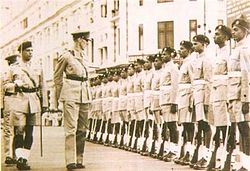
In 1948 Sri Lanka gained independence from Britain, becoming a Dominion within theCommonwealthand a year earlier Ceylon entered into the bi-lateral Anglo-Ceylonese Defence Agreement of 1947. This was followed by the Army Act No. 17 of 1949 which was passed byParliamenton April 11, 1949, and formalised in Gazette Extraordinary No. 10028 of October 10, 1949 marked the creation of the Ceylon Army, consisting of a regular and a volunteer force, the later being the successor of the disbanded CDF.[13][14]Therefore, October 10, 1949, is considered the day the Ceylon Army was raised, and as such October 10 is celebrated annually as Army Day.BrigadierJames Sinclair,Earl of Caithnesswas appointed as Commandant of the Ceylon Army. The Defence Agreement of 1947 provided the assurance that British would come to the aid of Ceylon in the event it was attacked by a foreign power and provided British military advisers to build up the country's military. In November, a Ceylon Army Guard takes over duties atEchelon Barracksfrom the Guard of theBritish Army.[15]
TheArmy Headquarters, Ceylonwas established in Colombo, with aGeneral Staff Branch,anAdjutant General Branch,aQuartermaster General Branchand a Pay and Records Branch. Soon after theHeadquarters, Ceylon Volunteer Forcewas established. The initial requirement was to raise an artillery regiment, an engineer squadron, an infantry battalion, a medical unit, and a service corps company. For much of the 1950s the army was preoccupied with the task of building itself and training existing and new personnel. To this aim the British Army Training Team (BATT) advisory group carried out training for ex-members of the CDF within the Ceylon Army,field rank officerswere sent to the British ArmyStaff College, Camberleyand some attached to units of theBritish Army of the Rhineto gain field experience. Newly recruited officer cadets were sent for training atRoyal Military Academy, Sandhurst,stating with 10 officer cadets in 1950, which continued until the 1968 and both officers and other ranks were sent to specialist training courses in Britain, India, Pakistan and Malaya. There were no formations and all units were structured to directly function under the Army Headquarters. However temporary field headquarters were to be formed at the time requirement arose.[14]
Due to a lack of any major external threats, the growth of the army was slow, and the primary duties of the army quickly moved towards internal security by the mid-1950s, the same time as the first Ceylonese Army CommanderMajor GeneralAnton Muttukumarutook command of the army. The first internal security operation of the Ceylon Army began in 1952, code namedOperation Montyto counter the influx of illegal South Indian immigrants brought in by smugglers on the north-western coast, in support ofRoyal Ceylon Navycoastal patrols and police operations. This was expanded and renamed asTask Force Anti Illicit Immigration(TaFII) in 1963 and continued up to 1981 when it was disbanded. The Army was mobilised to help the police to restore peace under provincial emergency regulations during the1953 hartal,the1956 Gal Oya Valley riotsand in 1958 it was deployed for the first time under emergency regulations throughout the island during the1958 Riots.[16]
During the 1950s and 1960s the army was called upon to carry to essential services when the workers went on strike which were organised by the left-wing parties and trade unions for various reasons, the most notable was the 1961 Colombo Port strike, during which ships threatened to bypass Colombo port and the country almost starved. To counter these common strikes several units were formed, who were employed in development work when there were no strikes. New regiments were formed, which included theCeylon Armoured Corps,Ceylon Sinha Regimentand theCeylon Pioneer Corps.[16]
In 1962 several senior officersattempted a military coup,which was stopped hours before it was launched. Thereafter the government mistrusted the military and reduced the size and growth of the army, especially the volunteer force, disbanding several units and forming theGemunu Watch.

In 1971, the Army found itself facing a full blowninsurgency,when theJVP Insurrectionbroke out in April 1971. Having been caught by surprise, as a result of failure to comprehend the magnitude of the insurgency from intelligence reports. Although completely ill-prepared to deal with an insurgency, lacking weapons, ammunition, equipment and training; the army responded quickly and successfully defeated the insurgency by theJanatha Vimukthi Peramunaby mid 1971.
In May 1972, when Ceylon was proclaimed a republic and changed its name from the Dominion of Ceylon to the Republic of Sri Lanka, all Army units were renamed accordingly.[17]
By the late 1970s the army was confronted with a new conflict, this time withTamil militant groupsin the north of the island. TheLiberation Tigers of Tamil Eelam(LTTE) emerged as the prominent of these Tamil militant groups. The war escalated to the point where India intervened as a peacekeeping force. This was later seen as a tactical error, as theIndian Peace Keeping Forceunited nationalist elements such as the JVP to politically support the LTTE in their call to evict the IPKF. This led to asecond insurgency by the JVP,forcing the army to deploy its forces in the south of the island and to fight on two fronts between 1987 and 1989. The 1980s saw a massive expiation of the army from 15,000 personal to over 30,000 and more. New regiments were raised, while others were expanded with new battalions. New weapons and equipment were introduced as the war shifted fromcounter-insurgencytoconventional warfaretactics, with multibattalion,brigadeanddivisionscale operations. New regiments were formed which included theCommando Regiment,Special Forces Regiment,Mechanized Infantry Regiment,Gajaba Regiment,Vijayabahu Infantry Regiment,Military Intelligence Corps,Sri Lanka Army Women's Corps,Sri Lanka Rifle Corpsand theSri Lanka National Guard.
The war with the LTTE was halted several times for peace negotiations, the last of which following the signing of a ceasefire agreement in 2002 with the help of international mediation. However, renewed violence broke out in December 2005 and following the collapse of peace talks, the Army has been involved in the heavy fighting that has resumed in the north and east of the country.
Since 1980 the army has undertaken many operations against the LTTE rebels. The major operations conducted by the army eventually led to the recapture ofJaffnaand other rebel strongholds. On 19 May 2009 Sri Lankan army declare the victory of war as they found the dead body of LTTE leaderVelupillai Prabhakaran.This marked the end of the war, with the LTTE ceasing to exist in Sri Lanka as a result of prolonged military offensives conducted by Sri Lanka army.[18]The Sri Lankan Armed Forces, including the army, have been accused of committingwar crimesduring the war, particularly during the final stages.[19][20]Apanel of expertsappointed byUN Secretary-GeneralBan Ki-moonto advise him on the issue ofaccountabilitywith regard to any alleged violations ofinternational human rightsandhumanitarian lawduring the final stages of the civil war found "credible allegations" which, if proven, indicated thatwar crimesandcrimes against humanitywere committed by the Sri Lankan Armed Forces and the Tamil Tigers.[21][22][23]
Deployments
[edit]
As of present, the bulk of the Sri Lankan Army is deployed for domestic defensive and combat operations, while a sizable foreign deployment is maintained.
Domestic
[edit]Due to theSri Lankan Civil Warthe army has been on a constant mobilized (includingvolunteers) state since the 1980s. The majority of the army has been deployed in the North and Eastern provinces of the country, which includes 14Divisionscoming under six operational headquarters and 2 independent Divisions and several independentBrigades.The army is also based in other parts of the island for internal security including a Division for the defence of the capital.
Foreign
[edit]The Sri Lanka Army currently participates in several major overseas deployments:
- Lebanon– amechanized infantrycompanywith combat support personal in theUnited Nations Interim Force in Lebanonsince November 2010.[24]
- South Sudan– Sri Lanka Army's entry into South Sudan in 2014 as the newest member in the UN peace keeping family, marks a milestone in the Army history. Sri Lanka became the first country to deploy a surge contingent in South Sudan.Army maintains a SRIMED Level 2 Hospital, manned entirely by Sri Lanka'sSri Lanka Army Medical Corpspersonnel.[25][26]
- Mali– aninfantrybattalionwith support personal that has been deployed as part of theUnited Nations Multidimensional Integrated Stabilization Mission in Maliin 2016[27]
Peacekeeping
[edit]The Sri Lanka Army has taken part in twopeacekeepingmissions withUnited Nationsover the course of its history. First assignment was in theCongo(ONUC) (1960–1963). Most recently, following the signing of a ceasefire agreement was signed between the government and the LTTE in 2002, Sri Lankan forces were invited by the United Nations to be part of theUN peacekeeping forceinHaiti.In the process of the peacekeeping operations, two soldiers were killed in a raid in Petit-Goave.[28]After over 6 months of service, the first contingent of the peacekeeping force returned to Sri Lanka on May 17, 2005.[29]In December 2007, 7th rotation of the Sri Lankan contingent had been deployed with a force of 991 officers and other ranks, many of those deployed have been awarded theUnited Nations Medalfor their services.[30]In November 2007, 114 members of the 950 member Sri Lankan Army peacekeeping mission in Haiti was accused ofsexual misconduct and abuse[31][32]which resulted in 108 members, including three officers, being sent back after being implicated in alleged misconduct and sexual abuse where sex was exchanged for money and valuable items, with some acts considered rape as they involved those under 18.[33][32][34][35]In January 2019, a Sri Lankan army officer and trooper onpeace keeping duty in Maliwere killed and three more wounded when their convoy came under anIEDattack.[36]The incident prompted the army to accelerate itsAvalon program.[37]
Sri Lanka Army's newest contingent of 243 professionally-trained Army personnel in the Combat Convoy Company (CCC), well-prepared to serve in the United Nations (UN) Multidimensional Integrated Stabilization Mission in Mali (MINUSMA) left the island on 21 April 2021.[38]
Organization structure
[edit]The professional head of the army is theCommander of the Army.He is assisted by theChief of Staff of the Sri Lanka Armyand aDeputy Chief of Staff.TheCommandant of the Volunteer Forceis head of theArmy Volunteer Forceand is responsible for the administration and recruitment of all reserve units and personal. TheArmy Headquarters,housed in theDefence Headquarters ComplexinSri Jayawardenapura Kotteis the main administrative and the operationalheadquartersof the Sri Lanka Army.[39]
Administrative
[edit]TheArmy Headquartersis divided into a number of branches, namely theGeneral Staff(GS) branch responsible for coordination of operations and training and theAdjutant General's (AGs) branch responsible for personal administration, welfare, medical services, and rehabilitation. TheQuarter Master General's (QMGs) branch is responsible for feeding, transport, movement, and construction and maintenance. TheMaster General of Ordnance's (MGOs) branch is responsible for procurement and maintenance of vehicles and special equipment.[40]TheMilitary Secretary's Branch is responsible for handling all matters pertaining to officers such aspromotions,postings anddiscipline.Each branch is headed by an officer in the rank ofMajor Generalwho is directly responsible to the Commander of the Army for the smooth functioning of the Branch. Under each Branch, there are several Directorates, each headed by aBrigadier.[40]
The headquarters of field formations each have its own staff. For instance a divisional headquarters is divided into a GS branch as an AQ branch, each headed by aColoneland is responsible for operations & training and administration & logistics respectively. Similarly, aBrigadeMajorand Major AQ is responsible foroperationsand administration in abrigade.[40]
Like theIndian Army,the Sri Lanka Army has largely retained the British-style regimental system that it inherited upon independence. The individualregiments(such as theSri Lanka Light Infantryand theSri Lanka Sinha Regiment) operate independently and recruit their own members. Officers tend to remain in a singlebattalionthroughout their careers. Theinfantrybattalion, the basic unit of organization in field operations, includes five companies of four platoons each. Typical platoon has three squads (sections) of ten personnel each. In addition to the basic infantry forces, acommandoregiment was also established in 1986. Support for the infantry is provided by anarmouredregiment, fivereconnaissanceregiments, threemechanized infantryregiments, five fieldartilleryregiments, arocket artilleryregiment, three commando regiments, three special forces regiments, sixfield engineeringregiments, fivesignalsbattalions, amedical corps,and a variety of logistics units.[41]
Regiments and corps
[edit]Operational command
[edit]Organized and controlled by the Army General Staff at Army HQ, various formations are raised from time to time to suit various security requirements and operations in the country and overseas. The Army at present has deployed 12Divisions,7task forcesand several independentbrigades.Except for the11 Divisionbased at thePanagoda Cantonmentwhich is responsible for the maintenance of capability for the defence of the capital, all other divisions, task forces and brigades are deployed for operations in theNorthernandEasternprovinces of Sri Lanka, coming under five regionalcommandsknown asSecurity Forces Headquarters,which are the Security Forces Headquarters Jaffna (SFHQ-J), Wanni (SFHQ-W), East (SFHQ-E), Mullaittivu (SFHQ-MLT), West (SFHQ-W) and Central (SFHQ-C). One Security Forces Headquarters, theSFHQ-KLNwas disbanded in 2021.
Each SFHQ and most divisions are commanded by aGeneral Officer Commandingin the rank ofMajor General.A SFHQ has several divisions under its command and each division is further divided intobrigades.Each brigade is commanded by an officer in the rank ofBrigadierand has a number ofInfantrybattalions,support arms (Artillery,EngineersandSignals) and support services (Service Corps, Engineering Services, Ordnance Corps, Electrical and Mechanical Engineers) under assigned to it. There are also several administrative brigades (Artillery Brigade, Armoured Brigade, etc.) and theAir Mobile Brigade.
In other parts of the country, there are Area and Sub-Area Headquarters.Armour,Artillery,EngineersandSignalsUnits are grouped under Brigade Headquarters of their own arm; Armoured Brigade, Artillery Brigade and so on.
Formations
[edit]- Independent Brigade HQ
- Commander Security Unit
- 1 Corps,based inKilinochchi
- Reserve Strike Force
- 53 Division,based at Inamaluwa,Dambulla[42]
- Air Mobile Brigade
- 532 Brigade
- 533 Brigade
- 58 Division
- 581 Brigade
- 582 Brigade
- 583 Brigade
- 53 Division,based at Inamaluwa,Dambulla[42]
- Special Operations Force
- Commando Brigade
- Special Forces Brigade
- 51 Division,based inJaffna
- 511 Brigade
- 512 Brigade
- 513 Brigade
- 52 Division,based in theJaffna Peninsula
- 521 Brigade
- 522 Brigade
- 523 Brigade
- 55 Division,based inElephant Pass Military Base,Jaffna Peninsula[42]
- 551 Brigade
- 552 Brigade
- 553 Brigade
- Area Headquarters Mannar,Mannar
- 21 Division
- 54 Division
- 56 Division
- 61 Division
- 62 Division
- 22 Division,based inTrincomalee[43]
- 23 Division,based in Poonani,Batticaloa District[44]
- 24 Division
- 59 Division,operating in theMullaittivu District
- 64 Division, operating in theMullaittivu District
- 68 Division, Kombavil,Mullaittivu District
- 14 Division,based inColombo,Western Province(formerly Operation Command Colombo)
- 141 Brigade, based inGampaha
- 142 Brigade, based inColomboandKalutara
- 143 Brigade, based inPuttalamandKurunegala
- 61 Division
- Army Training Command
- Logistic Command
- Specialist Formations
- Engineers Division
- Armoured Brigade
- Artillery Brigade
- Mechanized Infantry Brigade
- Signals Brigade
- Corps of Agriculture and Livestock
Training
[edit]At the formation of the Ceylon Army in 1949, the need to train a standing army was felt strongly since the Ceylon Defence Force had operated on a regimental training model to maintain the efficiency of its volunteers culminating with the annual two week training camp at thegarrison townofDiyatalawa,in theBadulla Districtwhich became the traditional training grounds for the newly formed army. TheArmy Recruit Training Depotwas established in Diyatalawa in 1950 and later renamed as theArmy Training Centre.Officer cadets were sent to theRoyal Military Academy Sandhurst,along with specialized training at trade schools of the British Army, while officers offield rankwere sent to theStaff College, Camberleyand to theRoyal College of Defence Studies.With the economic limitations in the 1960s, focus was given for local training in order to save foreign exchange. The army initiated basic officer training at the Army Training Centre in 1968. With the rapid expansion of the army in the 1980s and 1990s saw the establishment of local specialist and trade schools, along with staff colleges and a defence university. At present the Army Training Command (ARTRAC) with its headquarters at Diyatalawa formulates all training doctrine of the army and all its training centres. ARTRAC directs all army training establishments, regimental training establishments and battalion training schools.[46]
All pre-commissioning training for officers are carried out at theSri Lanka Military Academy(SLMA) (formally theArmy Training Centre) and at theVolunteer Force Training School(VFTS) situated in Diyatalawa. The officer cadets graduating from SLMA are commissioned as officers in the regular and volunteer forces, while VFTS conducts shorter commissioning courses for prospective officers for the volunteer force and theNational Cadet Corps.The course for officer cadets runs for ninety weeks and includes training in tactics and administration which helps prepare the cadets to take up the positions ofplatoonandcompanycommanders. The course consisted of military and academic subjects and also trained the cadetsphysically.The course helps to promoteleadershipqualities and the understanding of each one's role as an officer and a servant of the state. Due to the lack of officers within the lower levels, the training process was sped up in the 1980s by developing a short commission course. The cadets were given a training of fifty-six weeks and devoted themselves to continue their careers in the military with the mandatory ten years of service for regular army officers and five years of service for volunteer officers. Once completing their basic training at SLMA, junior officers would receive specialized training at training centres which would include young officers courses in their area of specialization followed by advanced training on weapon systems.[40][41]
Selectedfield officersattended command and staff courses at theArmy War Collegefollowed by theCommand and Staff Courseat theDefence Services Command and Staff College(DSCSC) at Batalanda, Makola which was established in 1997 as the Army Command and Staff College. Officers may attend specialist long courses such as the Logistics Staff Course that is conducted at theArmy School of Logisticswhich was established in 2011. Senior field officers with the potential to advance to general officer rank are selected to attend the prestigiousNational Defence College(NDC) inColombowhich is the highest level of military training in Sri Lanka.[40][41]
TheGeneral Sir John Kotelawala Defence University(KDU) formed in 1981 and situated inRatmalana,fourteen kilometres south ofColombo,as only university specializing in defence studies in the island. Each year, approximately fifty cadets from all three services are admitted to the university (aged 18–22) to participate in a three-year programme of academic work and as sent to their service academies for their final year of training. In addition KDU conducts postgraduate and masters programs in defence related subjects for officers who attend staff and defence courses at DSCSC and NDC.[40][41]
Training for the new recruits are carried out by theArmy Training Schoolin Maduru Oya and at several locations by training battalions, followed by additional specialized training in arms or trade at training centres such as theInfantry Training Centrein Minneriya and theCombat Training Schoolin Ampara.[40][41]
At its formation the armed forces of Sri Lanka had limited indigenous training facilities, especially in technical and advanced roles, they have depended greatly on military training provided by foreign countries. The United Kingdom played a major role in the early years following independence and have continued to be an important source of military expertise to the Sri Lankan military. Other sources include India, Pakistan, the United States, Australia and Malaysia. Additionally, in an agreement reached in 1984, Israeli security personnel (reportedly fromShin Bet,the Israelicounterespionageand internal security organisation) trained army officers incounterinsurgencytechniques. With the rapid expansion of the army, in recent years it has expanded its training facilities locally.[41]
The Sri Lankan Army has also provided special training to theUnited States Armyon their request as well as many other countries in military education regarding civilian rescue, jungle combat, and guerilla warfare etc.[47]
Training establishments
[edit]|
Training Centres[48]
|
Regimental Training Centres[48]
|
Personnel
[edit]As of 2024 the Sri Lanka Army had 150,000 personnel.[1]In 2023 the army had 200,783 personnel and the number was reduced to 150,000 in 2024.[1]
In late 1987, the army had a total estimated strength of up to 40,000 troops, about evenly divided between regular army personnel and reservists on active duty. The approximately 20,000 regular army troops represented a significant increase over the 1983 strength of only 12,000. Aggressive recruitment campaigns following the 1983 riots raised this number to 16,000 by early 1985.[41]By 1990 the army had expanded to over 90,000 personnel and by 2007, it had expanded to over 120,000.[49]
Since the Sri Lankan armed forces areall volunteerservices, all personal in the Sri Lanka Army have volunteered as regular personnel or reservists. This should not be confused with the traditional termvolunteersused for reservists or reservist units. Recruitment of the personal are carried island wide with a restrictions in the northern and eastern provinces during the civil war in those areas. TheRifle Corpsis the only territorial unit that carries out recruitment from a specific area.
Parama Weera Vibhushanaya recipients
[edit]TheParama Weera Vibhushanayais the highest award for valour awarded in the Sri Lankan armed forces. Army recipients include;
- ColonelA.F. Lafir†
- Lieutenant-ColonelLalith Jayasinghe†
- MajorG. S. Jayanath†
- MajorK. A. Gamage†
- MajorW.M.I.S.B. Walisundara†
- CaptainSaliya Upul Aladeniya†
- CaptainH. G. M. H. I. Megawarna†
- LieutenantU. G. A. S. Samaranayake†
- Second LieutenantK.W.T. Nissanka†
- Warrant Officer 2nd ClassPasan Gunasekera†
- Staff SergeantH. G. S. Bandara†
- SergeantD. M. S. Chandrasiri Bandara†
- SergeantP.N. Suranga†
- SergeantA.M. Anura†
- CorporalGamini Kularatne†
- CorporalK. Chandana†
- CorporalP. M. Nilantha Pushpa Kumara†
- CorporalA. M. N. P. Abesinghe†
- Lance CorporalW. I. M. Seneviratne†
- Lance-CorporalT. G. D. R. Dayananda†
- Lance-CorporalR. M. D. M. Rathnayake†
- Lance-CorporalA. M. B. H. G. Abeyrathnebanda†
- Lance-CorporalK.G.M. Rajapaksha†
Notable fallen members
[edit]Over 23,790 Sri Lankan armed forces personnel were killed since the begin of the civil war in 1981 to its end in 2009, this includes 12 general officers killed in active duty or assassinated.[50]659 service personnel were killed due to the secondJVP Insurrectionfrom 1987 to 1990. 53 service personnel were killed and 323 were wounded in the firstJVP Insurrectionfrom 1971 to 1972.[51]Notable fallen members include;
- Lt. Gen.Denzil Kobbekaduwa†–Overall Operational Commander,Northern Sector.[52]
- Lt. Gen.Parami Kulatunga†– FormerDeputy Chief of the Staff of the Army.[52]
- Lt. Gen.Nalin Angammana†– FormerGOC,3 Division.[53]
- Maj. Gen.Vijaya Wimalaratne†– Former Jaffna Brigade Commander.[52]
- Maj. Gen.Lakshman 'Lucky' Wijayaratne†– Former brigade commander, 22 Brigade.[53]
- Maj. Gen.Percy Fernando†– Former deputyGOC,54 Division.[53]
- Maj. Gen.Larry Wijeratne†– Former brigade commander, 51-4 Brigade.[53]
- Maj. Gen.Susantha Mendis†– Former brigade commander, 51-2 Brigade.[53]
- Maj. Gen.Janaka Perera– FormerChief of Staff of the Sri Lanka Army,Overall Operational Commanderof Northern Sector, General Officer Commanding (GOC) of the 53 Division.
- Maj. Gen.Ananda Hamangoda†– Former brigade commander, 51-2 Brigade.[54]
- Brig.Ariyasinghe Ariyapperuma†– Former Commander, Northern Command
- Brig.Bhathiya Jayatilleka†– former Brigade commander, 54-1 brigade
- Brig.Rohitha Neil Akmeemana†– former Brigade commander, Elephant Pass.[53]
- Col.Tuan Nizam Muthaliff†– Former commanding officer 1st Battalion Military Intelligence Corps.[55]
- Maj.Noel Weerakoon†– first army officer killed in action (during the1971 Insurrection).
Directorate of Rehabilitation
[edit]The Directorate of Rehabilitation was established with the intention and focus towards the rehabilitation of Officers and Other Ranks Wounded in Action. However, with the increase of a number of casualties due to the operations, the Sri Lanka Army proceeded to utilize the services of battle casualties with the view of obtaining a productive service from these individuals. As a result, under mentioned institutes had been established.[56]
- Ranaviru Sevana
- Ranaviru Apparels
- Abhimansala Wellness Resort 1 (Anuradhapura)
- Abhimansala Wellness Resort 2 (Kamburupitiya)
- Abhimansala Wellness Resort 3 (Panagoda)
- Ranaviru Resources Centre
- Mihindu Seth Medura
Equipment
[edit]In the 1980s, the army expanded its range of weapons from the original stock ofWorld War II-era BritishLee–Enfield rifles,Sten Submachine guns,Vickers machine guns,Bren machine guns,6-inch coastal guns,Daimler Armoured Cars,Bren Gun Carriers,[57]40 mm anti-aircraft guns,3.7-inch heavy anti-aircraft gunsand 4.2-inch heavymortarsas well as post warAlvis Saladins,Alvis Saracen,FerretsandShorland S55s.New sources of weaponry in the mid-to-late 1970s included theSoviet Union,Yugoslavia,andChina– countries with which the leftistBandaranaikegovernment had close ties.
To meet the threat posed by predominantly the LTTE, Army purchased modern military hardware including 50-calibreheavy machine guns,rocket-propelled grenade(RPG) launchers,Night Vision Devices,106 mm recoilless rifles,60 mm and 81 mmmortars,40 mmgrenade launchersand somesniper rifles.Refurbishedarmoured personnel carrierswere added to the 'A' vehicle fleet of the 1st Reconnaissance Regiment,Sri Lanka Armoured Corps.These APCs enabled the Armoured Corps to have their own assault troops to provide close contact protection to theirAlvis SaladinandFerret Scout Carswhich were vulnerable toanti-tankweapons. The capability of theSri Lanka Artillerywas enhanced with the introduction ofOrdnance QF 25 pounders.[41][58]Chinese-made 122 mm, 130 mm and 152 mm howitzers were introduced to the Sri Lankan Army in 1995 and 1998 whilst 122 mm Multi Barrel Rocket Launchers (MBRL), were first used in 2000 by the Sri Lanka Army.[59]
Though the weapons were obsolete at the time of purchase, security forces found them to be successful in combat. Land mines proved to be the most lethal threat to personnel, as a number of mines were deployed against unprotected trucks and buses by the LTTE in the northern and eastern Provinces. These land mines weighed approximately 50 – 100 kg, against which no armoured vehicle that the SLA possessed was able to withstand the blast effect. Consequently,ArmscorBuffels–South Africanarmoured personnel carriers constructed on aUnimogchassis – were imported in quantity. By 1987 Sri Lanka's indigenousUnicorn APChad been engineered from the Buffel, followed by the improvedUnibuffelclass.[60]Both the Unicorn and the Unibuffel are assembled by theSri Lanka Electrical & Mechanical Engineers(SLEME).[41][58]
In recent years, Sri Lanka has become increasingly reliant on China for weapons.[61]This is due to mostEuropean nationsand the United States Governments passing regulations about the selling of weaponry to nations which are suffering or suffered from internal conflict.[62]However the United States has expressed its intent to maintain military training assistance. Recently the Sri Lankan Army started to produce locally weapons such as a new multiple rocket launcher, with 10 barrels and a firing range of 20 km.[63]The SLEME is also producing vehicles for transport, theUniCOLTseries trucks,[64]and landmine-resistant vehicles, theUniAIMOVsand theUniAVALONs.[65]In 2020, the Army shipped several modernized Unibuffels to the Sri Lankan forces who are serving in a peacekeeping mission in Mali.[66]
Sri Lanka also continues to receive a variety of weapons from Britain, India, Japan, Pakistan, Israel and other former suppliers.[61][67]
Armour
[edit]
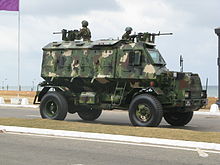
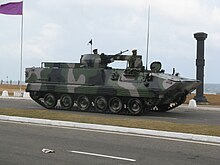



Multi Purpose Trucks
[edit]| Type | Origin | Quantity | Notes |
|---|---|---|---|
| UniCOLT | N/A | Multi Purpose Truck | |
| TataModel 1210 SD | Field Artillery Tractor | ||
| Tata Defence Troop Carrier LPT 709 | Troop carrier | ||
| Ashok Leyland Stallion | Troop carrier | ||
| NORTHBENZ Tiema XC2200 | Troop carrier, Field Artillery Tractor | ||
| Tatra 815 | / |
Troop Carrier, Heavy Equipment Transporter | |
| Sinotruk HOWO 371 | Heavy Equipment Transporter | ||
| Tata LPTA 1628 6x6 | Used for UN missions. |
Artillery
[edit]| Type | Image | Origin | Quantity | Notes |
|---|---|---|---|---|
| MRLS | ||||
| RM-70 | 
|
22[3] | 20,7 km range | |
| KRL-122 | Pakistan | 6[3] | 45 km range | |
| Towed artillery | ||||
| D-20 | 
|
46[3] | 17,4 km range | |
| Type-59-1 | 
|
30[3] | 27 km range | |
| Type-83 | 
|
20[3] | 19 km range | |
| Mortars | ||||
| PM-43120mm | 
|
55[3] | 5,7 km range | |
| 82mm | 
|
unknown | 209[3] | |
| 81mm | 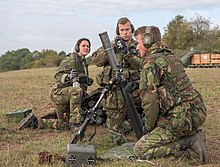
|
unknown | 520[3] | |

Special Vehicles
[edit]| Type | Origin | Quantity | Notes |
|---|---|---|---|
| BJ2022 | 10[73] | Field Communication Vehicle |
Infantry weapons
[edit]Welfare
[edit]Sri Lanka Army Seva Vanitha Unit
[edit]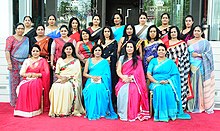
Inaugurated on 12 July 1984,[79]Sri Lanka Army Seva Vanitha Unit[80]functions with the main objective of providing welfare facilities to the next of kin of war heroes who have sacrificed their lives, gone missing in action or injured whilst defending the sovereignty and territorial integrity of their motherland while also empowering the families of the serving Army personnel. Traditionally the organization functions under the leadership of the wife of the servingCommander of the Army,and the members are the spouses of Army Officers as well as Lady Officers. The organization extends to 22 Regimental branches[81][79]functioning under the patronage of the wives of the respective Regimental Commanders.
Sri Lanka Army Seva Vanitha Unit conducts various welfare projects such as Viru Kekulu pre-schools, day care centres, welfare shops, bakeries and salons,[82]with the committed contribution of the dedicated membership. Construction of houses, giving away of educational scholarships and assisting in times of natural disasters, are done at both organizational and Regimental levels. The volunteer service extended by the spouses of the Army Officers whilst multitasking at their roles as wives, mothers and professionals, is an immense strength to Sri Lanka Army.[82]
Gallery
[edit]- Sri lanka Army
-
SLAHJ-8.
-
BMP-2infantry fighting vehicle
-
SLAUnibuffel.
-
SLA MIR weapons
-
SLA Bomb Disposal Units on Victory Day Parade.
-
WZ551(Type 92) infantry fighting vehicles.
-
Combat Rider Teams,Special Forces Regiment
See also
[edit]- Awards and decorations of the military of Sri Lanka
- Uniforms of the Sri Lanka Army
- Sri Lanka Army ranks and insignia
- Sri Lanka National Guard
Further reading
[edit]- Army, Sri Lanka. (1st Edition – October 1999).Sri Lanka army: 50 years on, 1949–1999ISBN978-955-8089-02-6
References
[edit]- ^abcd"Sri Lanka's plan to downsize military Tri-forces halt general recruitment".dailymirror.lk.Archivedfrom the original on 26 September 2024.Retrieved11 March2024.
- ^"SL celebrates 70th Army Day".themorning.lk.10 October 2019.Archivedfrom the original on 18 April 2021.Retrieved2 October2020.
- ^abcdefghijklmnopThe Military Balance 2024, p.313
- ^"Mahesh Senanayaka new Army Commander".www.dailymirror.lk.Archivedfrom the original on 26 September 2024.Retrieved11 May2020.
- ^"Lieutenant General Mahesh Senanayake appointed as new Army Commander".www.defence.lk.Archived fromthe originalon 4 July 2017.
- ^"Commander-in-Chief Completes One Year in Office".Media Centre for National Security. 8 March 2007. Archived fromthe originalon 28 September 2007.Retrieved20 April2007.
- ^"Sri Lanka Army History, The Ancient Time".Sri Lanka Army.Archived fromthe originalon 2 February 2007.Retrieved4 February2007.
- ^abcdefghijklArmy, Sri Lanka (October 1999). "Chapter 1".Sri Lanka Army,"50 YEARS ON" – 1949–1999(1st ed.). Colombo: Sri Lanka Army. pp. 1–3.ISBN978-955-8089-02-6.
- ^"The Portuguese in Sri Lanka (1505–1658)".WWW Virtual Library – Sri Lanka.Archivedfrom the original on 4 February 2012.Retrieved30 June2004.
- ^Doyle, Arthur Conan (2014).The Great War: the British campaign in France and Flanders. Volume 1.London.ISBN978-1-78394-624-2.OCLC865473156.Archivedfrom the original on 4 July 2020.Retrieved4 July2020.
{{cite book}}:CS1 maint: location missing publisher (link) - ^"Indias.com, Sri Lankan Army".Indias.Archived fromthe originalon 22 March 2006.Retrieved4 February2006.
- ^"History of the Sri Lanka Light Infantry Regiment, Sri Lanka Army".Sri Lanka Army.Archived fromthe originalon 8 July 2006.Retrieved4 February2006.
- ^ab"Establishment, Sri Lanka Army".Sri Lanka Army.Archived fromthe originalon 26 March 2006.Retrieved4 February2006.
- ^ab"Sergei de Silva-Ranasinghe looks back at the early days of the Sri Lanka Army".Archivedfrom the original on 24 September 2015.Retrieved6 February2015.
- ^1950 Fergusons Ceylon Directory.Colombo: Fergusons.
- ^ab"An evolving army and its role through time, Sergei de Silva- Ranasinghe's article on the early days of the Sri Lanka Army".Archivedfrom the original on 24 September 2015.Retrieved6 February2015.
- ^"Sri Lanka Army Marks 50 Years".Washingtonpost, AP News. 10 October 1999. Archived fromthe originalon 10 November 2012.
- ^Sri Lanka's Tamil Tigers admit defeatArchived31 July 2009 at theWayback MachineChristian Science Monitor – May 17, 2009
- ^"Rajapaksa vows to shield his army from international probe".The Indian Express.27 May 2011.Archivedfrom the original on 8 February 2016.Retrieved14 June2015.
- ^"Sri Lankan army agrees to probe war crimes".The Daily Telegraph.Agence France-Presse.15 February 2012.Archivedfrom the original on 12 January 2022.
- ^"Report of the UNSG's panel of experts on accountability in SL".The Island, Sri Lanka.16 April 2011.Archivedfrom the original on 23 April 2011.Retrieved14 June2015.
- ^"UN panel admits international failure in Vanni war, calls for investigations".TamilNet.16 April 2011.Archivedfrom the original on 18 April 2011.Retrieved14 June2015.
- ^"Summary of UN Panel report".Daily Mirror (Sri Lanka).16 April 2011.Archivedfrom the original on 19 April 2011.Retrieved14 June2015.
- ^"The Island".Archivedfrom the original on 6 February 2015.Retrieved6 February2015.
- ^"Army's UN Peace-Keeping mission opens a new Hospital in South Sudan".Archivedfrom the original on 22 August 2014.Retrieved20 August2014.
- ^"SL Army opens new hospital in South Sudan under UN Mission – South Sudan".ReliefWeb.13 August 2014.Archivedfrom the original on 4 July 2020.Retrieved4 July2020.
- ^"SL Army contingent invited for UN Peacekeeping in Mali | The Sunday Times Sri Lanka".Archivedfrom the original on 3 September 2016.Retrieved4 September2016.
- ^"2 U.N. peacekeepers killed in Haiti fighting".San Diego Union Tribune.21 March 2005.Archivedfrom the original on 4 February 2009.Retrieved13 March2007.
- ^"Sri Lanka Light Infantry UN Peacekeeping Operations".Sri Lanka Army.Archived fromthe originalon 4 February 2007.Retrieved16 March2007.
- ^"Sri Lankan troops in Haiti honoured".Archivedfrom the original on 5 April 2008.Retrieved2 April2008.
- ^Williams, Carol J. (15 December 2007)."U.N. confronts another sex scandal".Los Angeles Times.Archivedfrom the original on 26 September 2024.Retrieved7 November2008.
- ^ab"Sri Lanka to probe UN sex claims".BBC.3 November 2007.Archivedfrom the original on 4 November 2019.Retrieved5 November2007.
- ^"Haiti: Over 100 Sri Lankan blue helmets repatriated on disciplinary grounds – UN".United Nations.2 November 2007.Archivedfrom the original on 1 February 2009.Retrieved4 November2007.
- ^Reddy, B. Muralidhar (5 November 2007)."Part of Sri Lankan contingent in Haiti to be sent back".The Hindu.Archived fromthe originalon 6 November 2007.Retrieved5 November2007.
- ^"UN confirms sex charges".Sundaytimes.30 March 2008.Archivedfrom the original on 4 March 2016.Retrieved30 March2008.
- ^"SL army contingent attacked in Mali; Two killed, three injured".www.dailymirror.lk.Archivedfrom the original on 26 September 2024.Retrieved11 May2020.
- ^"New locally made MPV better at withstanding mines: SLEME | The Sunday Times Sri Lanka".Archivedfrom the original on 31 March 2019.Retrieved24 February2019.
- ^"Another Army contingent leaves for Mali on peacekeeping mission".21 April 2021.Archivedfrom the original on 26 September 2024.Retrieved30 April2021.
- ^"Sri Lanka Army Establishment | Sri Lanka Army | Organization structure".www.army.lk.Archivedfrom the original on 2 June 2020.Retrieved4 July2020.
- ^abcdefg"Military Balance, Sri Lanka".Institute of Peace and Conflict Studies.Archived fromthe originalon 2 October 2006.Retrieved14 March2007.
- ^abcdefghij"Training | Sri Lanka Army".Sri Lanka Army.Archivedfrom the original on 2 June 2020.Retrieved4 July2020.
- ^abcdTwo Security Forces Headquarters established in Mullaitivu, KilinochchiArchived2011-09-16 at theWayback Machine
- ^Security Forces on a realistic path to achieve the set target, DailynewsArchived2008-08-02 at theWayback Machine
- ^"Columns – Situation Report".Archivedfrom the original on 24 September 2015.Retrieved6 February2015.
- ^"Sri Lanka Army – Defenders of the Nation".Archived fromthe originalon 19 December 2014.Retrieved6 February2015.
- ^"Training | Sri Lanka Army".www.army.lk.Archivedfrom the original on 2 June 2020.Retrieved4 July2020.
- ^"Sri Lanka: Sri Lanka Army to train US Army".15 May 2010.Archivedfrom the original on 23 September 2015.Retrieved6 February2015.
- ^ab"Training, Sri Lanka Army".Sri Lanka Army.Archived fromthe originalon 10 April 2006.Retrieved4 February2006.
- ^"Country Reports on Human Rights Practices – 2000".U.S. State Department. 23 February 2001. Archived fromthe originalon 7 June 2001.Retrieved23 March2007.
- ^"Victory's price: 6,200 Sri Lankan troops".News.smh.com.au. 22 May 2009.Archivedfrom the original on 25 May 2009.Retrieved30 May2009.
- ^"The Sunday Times – Special Assignment".Archivedfrom the original on 3 March 2016.Retrieved6 February2015.
- ^abcKanagaraarachchi, Ramani (20 January 2007)."Heroes who made the supreme sacrifice".Daily News.Associated Newspapers of Ceylon. Archived fromthe originalon 30 September 2007.Retrieved25 May2007.
- ^abcdef"Heroes who made the supreme sacrifice".Archived fromthe originalon 30 September 2007.
- ^Ratnayake, Brigadier Daya (30 July 2005)."Noble in death as in life".The Sunday Times.Wijeya Newspapers Ltd.Archivedfrom the original on 1 February 2009.Retrieved18 August2007.
- ^De Silva, Senaka (1 June 2005)."Senior Army officer shot dead".Daily Mirror.Wijeya Newspapers Ltd. Archived fromthe originalon 30 September 2007.Retrieved3 June2007.
- ^"Directorate of Rehabilitation"(PDF).About, Inc.Archived(PDF)from the original on 2 June 2022.Retrieved10 April2017.
- ^Michael K. Cecil – Sri Lanka's Military: The Search For A Mission,[1]Archived29 September 2007 at theWayback Machine.
- ^abArmy, Sri Lanka (October 1999). "Chapter 1".Sri Lanka Army,"50 YEARS ON" – 1949–1999(1st ed.). Colombo: Sri Lanka Army. p. 393.ISBN978-955-8089-02-6.
- ^"Sri Lanka Army".army.lk.Archived fromthe originalon 7 July 2006.Retrieved25 July2016.
- ^"SFrom Unicorn to Unibuffel".sundayobserver.Archivedfrom the original on 30 September 2007.
- ^abBedi, Rahul (2 June 2007)."Sri Lanka turns to Pakistan, China for military needs".IANS.Urdustan.com Network. Archived fromthe originalon 4 June 2007.Retrieved2 June2007.
- ^"Small Arms and Light Weapons Conference Report"(PDF).Judith McDaniel.Archived(PDF)from the original on 13 March 2012.Retrieved23 July2006.
- ^"SL made multi-barrel rocket launcher unveiled".www.dailymirror.lk.Archivedfrom the original on 26 September 2024.Retrieved11 January2021.
- ^"'Made in Sri Lanka' UniCOLT Vehicles to be Manufactured at SLEME Workshop | Sri Lanka Army ".www.army.lk.Archivedfrom the original on 12 November 2020.Retrieved11 January2021.
- ^"Sri Lanka Army's innovative new workshop".Sri Lanka News - Newsfirst.15 December 2020.Archivedfrom the original on 27 January 2021.Retrieved11 January2021.
- ^KATUGAMPALA, MANOHARI."Military engineers achieve success with modified Unibuffels".Daily News.Archivedfrom the original on 13 January 2021.Retrieved11 January2021.
- ^"Naval surveillance is the millstone around LTTE's neck".P.K. Balachanddran.Archived fromthe originalon 20 November 2003.Retrieved17 October2003.
- ^abcSri Lanka Army EquipmentArchived10 February 2013 at theWayback Machine.globalsecurity.org. Retrieved on 2013-06-09.
- ^abcdefg"Arms transfer database".armstransfers.sipri.org.Archivedfrom the original on 10 May 2024.Retrieved21 May2024.
- ^"New locally made MPV better at withstanding mines: SLEME".The Sunday Times Sri Lanka.Archivedfrom the original on 31 March 2019.Retrieved6 January2021.
- ^"Sri Lanka Armoured Corps".alt.army.lk.Archivedfrom the original on 27 February 2024.Retrieved27 February2024.
- ^"Sri Lanka Armoured Corps".alt.army.lk.Archivedfrom the original on 27 February 2024.Retrieved27 February2024.
- ^https://army.lk/news/special-communication-vehicles-under-chinese-grant-delivered-armyArchived25 February 2024 at theWayback Machine[bare URL]
- ^abcdefghiSmith, Chris (October 2003).In the Shadow of a Cease-fire: The Impacts of Small Arms Availability and Misuse in Sri Lanka(PDF).Small Arms Survey. Archived fromthe original(PDF)on 12 August 2006.
- ^"T 81 Assault Rifle".SinoDefence.Archived fromthe originalon 14 February 2007.Retrieved14 March2007.
- ^"Accuracy International L96A1".www.MilitaryFactory.com. 16 January 2009.Archivedfrom the original on 16 September 2017.Retrieved20 January2009.
- ^"Biography of Mikhail Kalashnikov".VRQ International, Inc. 14 January 2004.Archivedfrom the original on 11 August 2003.Retrieved15 March2007.
- ^"If You're Involved in Resolving the".ibiblio.org. 5 January 1999.Archivedfrom the original on 2 November 2012.Retrieved15 March2007.
- ^ab"About Us: Army Seva Vanitha Unit".alt.army.lk.Archived fromthe originalon 28 May 2020.Retrieved1 December2018.
- ^"Welcome to Army Seva Vanitha Unit".alt.army.lk.Archivedfrom the original on 1 December 2018.Retrieved1 December2018.
- ^"Sri Lanka Army".www.army.lk.Archivedfrom the original on 1 December 2018.Retrieved1 December2018.
- ^ab"About Us: Army Seva Vanitha Unit".alt.army.lk.Archived fromthe originalon 28 May 2020.Retrieved4 July2020.









